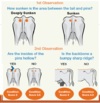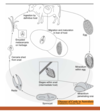GIT Flashcards
(281 cards)
Cow producing 30L of milk requires how much dry matter?

Half the number of liters plus five






Tail end of the 5 station exam

Left side 5 station clinical exam

Auscultation of the rumen and left flank
Normal:
- palpate doughy rumen, often with a small gas cap
- Primary contractions approximately every minute
- Secondary cycle approximately every 2 minutes
Abnormal:
- Palpate large gas cap which distends fossa
- Hypermotility (e.g. vagus indigestion)
- Hypomotility (e.g. hypocalcaemia, rumen atony)
- ping (rumen distension)

Percuss and auscultate body wall
* Requirements for pings
- gas distended viscus
- gas/fluid interface
- gas under pressure
- gas distended viscus might be against body wall
- both percussor and stethoscope must be over gas distended viscus
- viscus is singular of viscera

Left sided pings DDX


Abomasal ping
- high pitched/ resonant
- classic location
- beware milk fever!
Rumen ping
- a bit duller
- less resonant
- dorsal location
- can often palpate the gas cap

Auscultation and ballottement

Diagnosing a ping
Abomasal ping
- high pitched/ resonant
- classic location
- beware milk fever!
Rumen ping
- a bit duller
- less resonant
- dorsal location
- can often palpate the gas cap



Right sided auscultation/ percussion

Fluid splashing sounds audible on deep ballottement (succussion)?

5 station exam right side

5 station exam head/neck

5 station exam tail end revisted steps



Abnormal rectal findings include:


Abomasal torsion
Parameters of faeces to assess alimentary tract

5 station exam ancillary tests




























































































































































































































































































